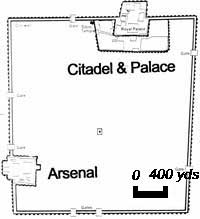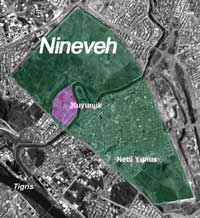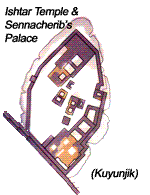Discuss the world's favourite imaginary friend on the JNE YouTube channel
1000 - 600 BC
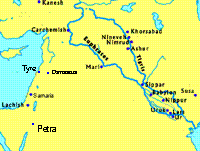
Between
the Tigris and Euphrates, Assyrians. On the coastal plain, 'Sea Peoples'
and Philistines. But
where were the Israelites?
In contrast
to the mythic empire of David and Solomon, the cities of Assyria, Phoenicia and Nabatea have left extant and extensive ruins.
Their artifacts are to be
found in all the major museums of the world.
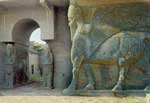
Nimrud - fortress
and capital of the Assyrian empire from about 879 to 706 BC.
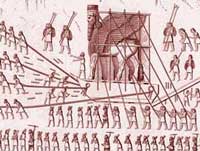
Assyria - under construction

Shalmaneser III (858-824),
a genuine Semitic imperialist. He defeated an alliance of the Syrian
kingdoms of Damascus and Hamah – and Ahab's Israel at Qarqur
in 854 BC.
No Evidence
"Unfortunately,
the archaeology of early Israel is silent in the sense that the excavated
monuments are virtually bereft of historical inscriptions, thus failing
to provide confirmation of the chronological framework for the biblical
narratives."
– Rohl (A Test
of Time, p10)

Tiglath-Pileser III (743
-727) transformed Assyria from a powerful kingdom into a true Empire.
Assyrian
inscriptions list the king's wars, booty
and buildings – just like the 'Book
of Kings' !

7th century BC Nineveh (a conjecture from the archaeological evidence!)
Why waste a good yarn?
The sojourn in Babylon was a time of inspiration for the priestly fraudsters of the Jews.
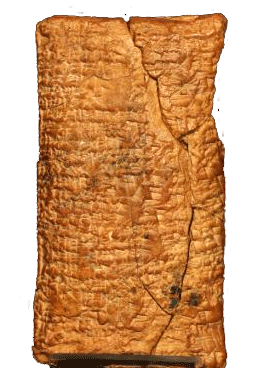
One Babylonian myth – recorded on a 4000-year-old clay tablet – tells of a decision by the gods to destroy the human race with a flood. But a dissenting god Enki chooses one man, Atram-Hasis, to build a boat and gather in wild animals, "two by two."
Atram-Hasis is instructed in great detail to build what amounts to a giant coracle, a scaled-up version of the round boats still used on the Tigris and Euphrates in the 1920s.
The Jewish priests made the story their own, changing some of the detail. For Atram-Hasis read Noah!
(see: Dr. Irving Finkel, Assyriologist at the British Museum)
|
Beginning in the Early Bronze Age (circa 3500 BC) pastoral nomads – indigenous
to the region – periodically
settled the Canaanite highlands. Settlement was a response to grain
shortage induced by disruption
of lowland agriculture. But then drought forced these marginal farmers back into nomadism
again. A second phase of settlement occurred during the Middle
Bronze
Age (from around
2000 BC) and a third, and final, period of highland settlement
occurred after 1200 BC.
The catalyst for this final phase of migration to subsistence farming was the collapse of the cities of Canaan, overwhelmed by an invasion
by the Sea Peoples. One consequence was that fringe subsistence
farmers in the hills became the original 'Israelites' – most settling in the central highlands
of Samaria, rather fewer further south in Judaea. But to the north and east of the sparse, tribal enclaves of the 'Israelites', expansive city-based empires were emerging that would overshadow their entire world. Foremost among them was Assyria, a terror and an inspiration to the Jews.
Rise
of Assyria
Sargon of
Akkad was the first king to assert control outside of his city-state
as early as 2371 BC. In 1813 BC Shamshi-Adad united the cities of Ashur,
Nineveh, Arbel and Nimrud into a cohesive unit – Assyria.
Several Assyrian empires rose and fell over the following 1200
years. The last period of imperial conquest began with Shalmaneser
III in the 9th century BC. Assyria's main rival, of course, was
Egypt.
Shalmaneser and Nimrud
(Kalah)
The Assyrian
king Shalmaneser III (858-824) ruled his empire from
the mighty city of Nimrud on the Tigris. The 37 metre
thick walls, 8 km in length, enclosed 3.6 sq km. (900
acres) of palaces, temples and parks and dwellings
for an estimated 63,000 inhabitants. The city was quadrilateral
in shape, with a Ziggurat in the south-west and “Fort
Shalmaneser” in the south-east.
After the
Assyrian intrusion into Syria/Palestine of 841 BC King
Jehu of Israel was forced to pay tribute. The Aramean
Kingdom of Damascus under King Hazael maintained a
protracted resistance.
|
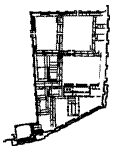
Shalmaneser's
fortified
palace at Nimrud
|
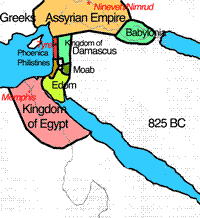
|
Four
warrior kings in particular built the Assyrian
Empire:
Shalmaneser
III (859-824), Tiglath Pilesar III (743-726),
Esarhaddon (680-669) and Assurbanipal (668-627).
The secret of their success appears to have
been iron-working, the war chariot, and
an efficient civil service collecting tax.
Hebrew
settlements to the southwest of Damascus
(the tiny 'Kingdoms of Judah and Israel')
were vassals of the Damascenes, who, for
a time, held the Assyrians at bay.
Some Semites escaped. Trading fleets out of Tyre established
a sea route to the western Mediterranean for the Phoenicians (the foundation for the future
'Carthaginian' maritime empire).
But all
the small kingdoms of Palestine were conquered by Assyria
about 725 BC and Egypt itself a century
later.
|
|
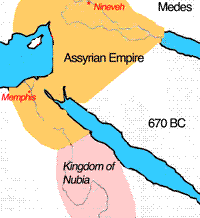 |
An Israelite Empire? Don't Blink!
"This
is what archaeologists have learned
from their excavations in the Land
of Israel ... the united monarchy of
David and Solomon, which is described
by the Bible as a regional power, was at
most a small tribal kingdom."
– Ha'aretz Magazine, October 1999.
|
|
|
|
|
Meanwhile,
in the Mountains ...
In the clash
of the Egyptian empire to the south west and the Assyrian/ Babylonian
empires to the northeast, the Israelites were at best
mercenaries and conscripts. The intrusion of Shalmaneser III in 841 BC – recorded
on Assyrian monuments – is not mentioned in the sacred
texts, but the subsequent fall of the northern kingdom of Israel
in 722 BC (to Sargon II, though erroneously credited to Shalmaneser
[V] in 2 Kings 17.6) is noted. Supposedly ‘10
tribes of the Jewish race’ were lost
through conquest.
"Therefore
the LORD was very angry with Israel, and removed them out
of his sight: there was none left but the tribe of Judah
only." – 2 Kings 17.18.
The traumatic
loss of most of the Israelite 'nation' was to be the catalyst
for a profound religious revolution: Yahweh priests,
fleeing south to the tiny enclave of Judah, stiffened Jewish
resistance by dreaming up the notion of a former 'great empire'
which, under priestly direction, would rise again.
In 701
BC the Assyrians returned, devastated Judah and occupied
the province. The Jewish king Hezekiah (715 - 687 BC) was besieged
in Jerusalem but plague compelled the Assyrians to move on.
Judah – reduced to little more than the environs of Jerusalem – maintained
a precarious existence for another century by costly tributes
to the Assyrian king.
Putting
a brave face on events, Hezekiah's priests heralded the reprieve
of Jerusalem as a victory for Yahweh!
Isaiah would
have us believe that overnight the 'angel of the LORD' smote
the Assyrians, leaving 185,000 to "arise early in
the morning, and behold, they were all dead corpses." (Isaiah,
37.36). (To give a comparison, Hadrian's legions wiped
Judaea off the map early in the 2nd century AD with about 40,000
troops.)
Over
the next half century "Judaism" emerged – a
religious response to the Assyrian assault and the total
loss of the northern kingdom.
Sargon's Khorsabad (Dur
Sharrukin)
Although his predecessor Shalmaneser IV gets the credit (2 Kings 17), the Assyrian Sargon II (722 - 705) made biblical headlines in his inaugural year by a campaign in the west which, among other triumphs, included the conquest of the northern kingdom of Israel and its capital Samaria.
Assyrians were settled in the province.
Yahweh priests fleeing south to Judah stiffened Jewish resistance by dreaming up the notion of a former 'great empire' which, under priestly direction, would rise again.
A triumphant Sargon returned to the Assyrian heartland and built himself a new capital – Khorsabad.
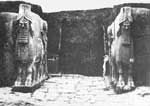
Evidence
of Khorsabad
Massive human-headed, winged bulls represented
the might of Assyria |
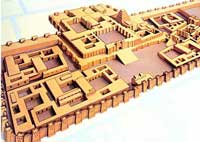
Reconstruction of Khorsabad
The city Khorsabad flourished after Sargon's death in 705
BC, though his son Sennacherib (705 - 681
BC) moved
the capital to Nineveh. |
|
Archaeology
has revealed the plan of Sargon II's capital Khorsabad:
It covered about 300 hectares (741 acres).
In comparison, 'Solomon's'
Jerusalem was 1/20th
size of Assyrian Khorsabad – and even that's just a theory!
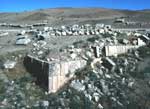
Extant
ruins of Khorsabad
Letters
to and from the royal architect
Tab-shar-Ashur, written on
clay tablets, reveal that cedar from Lebanon was used
extensively. |
Meanwhile,
in the Mountains (Part 2)
Hezekiah
was followed by his son Manasseh (686 - 642 BC) and grandson
Amon (641 -640) – both castigated in the sacred
texts for ignoring priestly dictates – but then a hero
of Judaism emerged: the 8-year-old Josiah. During
his 'guided' reign (639 - 609 BC) 'reform' elevated
the priests of Yahweh and eliminated the competition. Sacred 'high
places' in the countryside were destroyed and rival
priests were murdered. Communion with God now became a monopoly
of the Jerusalem Yahwehists.
Conveniently,
a second statement of 'The Law of Moses' – Deuteronomy – was 'found' in
the Temple to give the divine seal of approval.
To
graphically illustrate what was possible in a dynastic theocracy
the fable of the 'Yahweh-guided, fabulous kingdom' – of
Saul, David and Solomon – set 300 years earlier,
was now fleshed out in painstaking detail (Samuel, Kings,
Chronicles).
The
fable of 'Imperial Israel' – long on court
intrigue and adulteries but short on how the empire was
won – reflects incidental detail from the empires
the Israelites themselves faced as an enemy – the Assyrians
and Babylonians of the 9th - 6th centuries!
The
pious fantasy was further embellished in in the 6th and
5th centuries, in the aftermath of Babylonian conquest
of Judah and the "captivity" (597-539 BC).
Sennacherib's Nineveh
Sennacherib (705-681 BC) moved the Assyrian capital to Nineveh, a vast walled city of 7.5 sq km.
The Temple of Ishtar alone was half a kilometre long!
The
reality of Sennacherib''s Palace:
Fitments
to the Royal Palace of Sennacherib included three kilometres of carvings,
over 100 massive bulls and sphinxes and vast
quantities of Lebanese cedar, carried over 500
miles, and decorated with gold and silver.
In 701
BC Sennacherib devastated Judah, the
minor 'southern' kingdom allied with Egypt
and Phoenicia. The Assyrians occupied 46
walled towns and compelled the Jewish king
Hezekiah to shut himself up in Jerusalem "like
a bird in a cage."
Plague
compelled Sennacherib to abandon the siege
and Judah – reduced to little more than
the environs of Jerusalem – maintained
a precarious existence for another century
by costly tributes to the Assyrian
king.
Putting
a brave face on events, Hezekiah's priests
heralded the reprieve as a victory for Yahweh!
The
fantasy of Solomon's Palace:
"The
throne had six steps ... and two lions stood
beside the stays. And twelve lions stood there
on the one side and on the other upon the six
steps ... And all king Solomon's drinking vessels
were of gold, and all the vessels of the house
of the forest of Lebanon were of pure gold;
none were of silver: it was nothing accounted
of in the days of Solomon." – 1
Kings 10.19-21.
The
fantasy of vast tribute – and 666!
"And
when the queen of Sheba heard of the fame of
Solomon ... she gave the king an hundred and
twenty talents of gold, and of spices very
great store, and precious stones ... And the
navy also of Hiram, that brought gold from
Ophir ...
Now
the
weight of gold that came to Solomon in one
year was six hundred
threescore and six talents
of gold ...
So
king Solomon exceeded all the kings of the
earth for riches and for wisdom." – 1
Kings 10.4-23.
|
|
Egypt's
Last Bid for Empire: Pharaoh Nekau II
Herodotus records
that Nekau succeeded his father Psamtik I in 610 BC as pharaoh
and assigns him a reign of sixteen years. Monuments and artifacts
attest to his existence. It seems that the declining 7th
century Assyrian conquerors of Egypt installed a vassal called
Nekau (circa 655 BC) and this 'governor' in the delta was
the grandfather of the future pharaoh Nekau II.
Nekau
seems to have been an enterprising king: Herodotus writes
that he attempted to complete the canal connecting
the Red Sea with the Nile, and when he abandoned that project
he sent a Phoenician expedition to circumnavigate
Africa, which was successfully accomplished in three
years.
In real history,
Pharaoh Nekau II saw an opportunity to revive an Egyptian
empire in Syria by assisting his Assyrian ally after the
fall of Nineveh to the Babylonians in 612 BC.
Archaeologists,
aware that Josiah was in no position to challenge the mighty
Egyptian army, suspect that Nekau merely summoned Josiah
to some sort of royal parley and had him killed for unknown
reasons. With Josiah dead (609 BC) Nekau continued north
but was himself defeated at Carchemish (605 BC).
The
biblical Necho has a slightly different career ...
| |
At
last! – a genuine biblical pharaoh: 'Necho' |
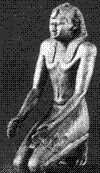
Nekau – Pharaoh,
6th century BC |
2
Kings and 2 Chronicles tell of Pharaoh Necho.
In
the biblical fantasy, for
no very good reason Josiah, King of
Judah, gets in the way of Nekau's
army, moving north. The odd behaviour of the
Judaean king includes 'disguise' and choosing
an unfavourable battleground. But Nekau
is on 'God's business' and Josiah
is being silly. The point, of course, is theological:
Don't you dare go against the Lord!
"Necho
king of Egypt came up to fight against
Carchemish by Euphrates: and Josiah went
out against him ... and hearkened
not unto the words of Necho from
the mouth of God, and came to
fight in the valley of Megiddo." – 2
Chr. 35.20,22.
In
this silly story, the polytheistic Egyptian
king has become the mouthpiece of the Hebrew "God" who
has sent him on a mission!
"But
he sent ambassadors to him, saying, What
have I to do with thee, thou king of Judah?
I come not against thee this day, but against
the house wherewith I have war: for
God commanded me to make haste: forbear
thee from meddling with God, who is with
me, that he destroy thee not."
– 2 Chr. 35.21.
In
a carefully woven weave, real history is mixed
into a sacred legend. In any event, the (mostly!)
righteous king is killed and Judah slides into
oblivion.
As
to Nekau giving 'Josiah' a knock-out blow
on his way to the Euphrates, Herodotus says
nothing – but then Herodotus had never
heard of the Jews anyway!
|
|
Babylon
On
his return from the northern front – according
to the Bible – Nekau installed a puppet king ('Jehoiakim')
in Jerusalem but poor Jehoiakim also "does evil
in the sight of the LORD" and gets his own divine
comeuppance – this time from Nebuchadnezzar of
Babylon (601 BC).
Judah
is conquered in 586 BC and its people carried
into exile.
In
the biblical story, Babylon's governor is murdered and fearing
retribution, Jews (that is, the ones who didn't get carried
into exile! ) – flee to Egypt. This includes 'Jeremiah,'
a phantom 7th century prophet created by the 3rd/4th
century BC scribe who wrote the entire Josiah saga (2
Chronicles, Jeremiah). At this stage
the Jews are under Persian rule, Egypt is weak but nominally
independent.
The
Jewish priestly scribe hammers home his point about 'bad
kings' indulging in 'foreign practices.' Reiterating the
central message of Deuteronomy (the "fifth
book of Moses") – supposedly 'found' during Josiah's
rebuilding of the Temple –, it looks forward to happier times,
when pious kings are controlled by priests and 'fear God':
"Thou
shalt in any wise set him king over thee, whom
the LORD thy God shall choose ... When he
sitteth upon the throne of his kingdom, that he
shall write him a copy of this law in a book
out of that which is before the priests the Levites:
And it shall be with him, and he shall read
therein all the days of his life: that he
may learn to fear the LORD his God ..."
– Deuteronomy
17.14,20.
 |
Kings
under priestly direction – biblical ideal |
Sources:
Paul Johnson, A History of the Jews (Phoenix Grant,
1987)
Dan Cohn-Sherbok, The Crucified Jew (Harper Collins,1992)
Henry Hart Milman, The History of the Jews (Everyman, 1939)
Josephus, The Jewish War (Penguin, 1959)
Leslie Houlden (Ed.), Judaism & Christianity (Routledge, 1988)
John Romer, Testament (Viking, 1999)
Thomas L. Thompson, The Bible in History (Pimlico, 2000)
Israel Finkelstein, Neil Silberman, The Bible Unearthed (Simon & Schuster,
2001)
Ahmed Osman, Moses Pharaoh of Egypt (Grafton, 1990)
B.S.J. Isserlin, The Israelites (Thames & Hudson,
1998)

|
 |

|

|
Some fifty articles are now available as a book.
For your copy order:

|
|
|
|
|
Copyright © 2004 by Kenneth
Humphreys.
Copying is freely permitted, provided credit is given to the author and no material
herein is sold for profit. |
|
|













